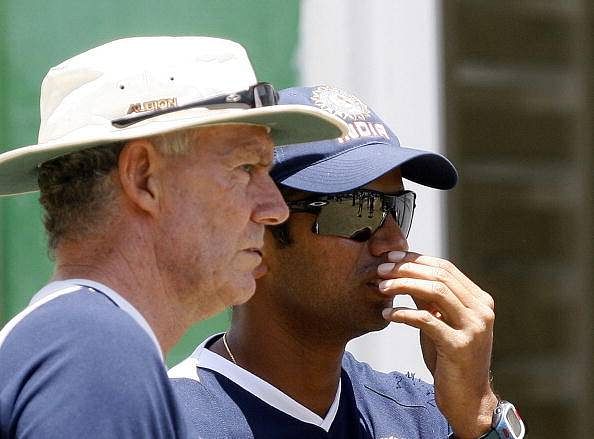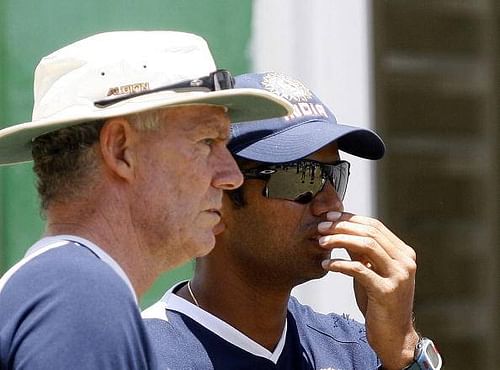
Why the Dravid-Chappell combo deserves more credit than it gets

The period between late 2005 and mid-2007 holds tremendous significance in the history of Indian cricket. Not only did it manage to create a furore on an international platform, but also scarred the souls of many a cricket lover, the wounds of which still stay fresh in the memory of Indians. Much has been said and written about the strings of incidents; the facts – and even sensational extrapolations – lay bare on the global web.
What strikes me though is the complete vilification of one man dominating the theme and content of any and every article to be found on Google concerning the period. Defence, as is evident, is entirely absent for either protagonist of what has been dramatized as the Dravid-Chappell era, while empathy seems to know no bound for the man wronged, Sourav Ganguly.
The ideas propagated regarding Greg Chappell are so steeped in negativity, with the Australian being put up as an embodiment of evil sent from the very depths of hell to disseminate malevolence in the mortal world, that one is actually inclined to believe that all is dark about him. A fair, unbiased account of his tenure needs to be shown the light of publication, and it is that which I wish to record in the following sections.
The unadulterated facts
First things first. One of the major reasons behind Chappell’s tenure being frowned upon unanimously is his abysmal man-management skills. Plenty of senior cricketers have gone on record voicing their disapproval of Chappell’s management tactics. Sachin Tendulkar, with perhaps the best insight into the episode, has had some unflattering observations regarding the Australian’s role in the dressing room in his recent autobiography.
The Australian’s activist attitude and total nonchalance towards the media didn’t help his cause either. Demanding the skipper’s axing in the middle of a tour based on his batting performances and fabricating stories against the same, as proved by the subsequently leaked email, are never ideal from a coach. The leaked email, apart from exposing serious cracks in the Ganguly-Chappell relationship, did a lot to bring down the image of the latter courtesy negative publicity.
His preference for autocracy and insistence on getting things done his way ended up destroying the environment in the dressing room. The players had ceased enjoying their game and their self-confidence had hit rock-bottom.
The stats paint a different picture
The on-field results, contrary to popular belief, however, were extremely encouraging. In Tests, India emerged victorious on 18 occasions during his tenure with four losses and seven draws. Rahul Dravid achieved the feat of winning two overseas Test series (West Indies in 2006 and England in 2007) while at the helm. That no other India captain after Ajit Wadekar had done this spoke volumes about Dravid’s leadership capabilities.
Beginning from October 2005 and running till May 2006, India won 17 consecutive ODIs under Dravid. The skipper had been well aware of his team’s weakness while chasing and preferred to attack the problem head-on. As is recorded in Chappell’s anecdotes, Dravid would continue to choose fielding after winning the toss irrespective of the conditions – a practice that ultimately earned him 14 consecutive triumphs while chasing.
The majority of these successes were tailored by Dravid himself, MS Dhoni and Yuvraj Singh. Till mid-2005, i.e. under Ganguly, India bragged about a half-decent chasing record of 23-32 in ODIs. Following series victories against Sri Lanka (6-1), England (5-1) and Pakistan (4-1), this catapulted to 23-14 under Dravid.
But then, the poor man’s argument goes: “There are lies, damned lies, then there’s statistics.”
Scouting talent
Let me sketch a bigger picture. If one has a look at the 2011 World Cup winning squad, one would notice that a lot of the players earned their first chance during the Australian’s tenure. Yes, the seeds of ultimate glory were sown under Chappell, although they blossomed only after his departure.
As a purist during his cricketing days, it is safe to assert that Chappell’s knowledge about the game is unparalleled. His sharp cricketing brain and amazing insights have been put on display several times in his articles, as is seen here. It is perhaps this which made him an astute talent scout – one of the qualities that had earned him a recommendation from Ganguly to the BCCI.
No less than 29 players batted in the top seven when Dravid was the skipper. The notable names include Gautam Gambhir, Robin Uthappa, Suresh Raina and Dinesh Karthik. On the bowling front, the foremost talent that was unearthed with the help of Chappell’s expertise goes by the name of S Sreesanth.
But then, authoritarianism has its cons
However, the Australian had his own eccentric means of taking home his due. Always keen on improvements, Chappell had tried to carve out an all-conquering allrounder in Irfan Pathan with the ultimate consequence of the pacer losing both his lethal swing and batting handiness. Seeking perfection turned out to be Chappell’s chief flaw as he persisted with altering Sehwag’s footwork and front-foot play.
Naturally, this irked the seniors who found themselves uncertain of a place in the team courtesy of both the captain and the coach being keen on encouraging the youth and forging a hyper-flexible batting order. Fielding emerged as one of the primary criteria for selection under Chappell, whose obstinacy at imbibing the Australian approach into the Indian team came in for a lot of flak.
Management issues, however, contrary to popular belief, do not undermine the fact that his efforts, albeit not instantaneously fruitful, were aimed at benefitting the country’s cricket. As mentioned by Dean Jones here, Chappell’s uniqueness lay in his ‘outside the square’ thinking and his proactive stance aimed at winning matches, even at the expense of benching seniors – again, a key reason for his infamy among the Indian masses.
It’s not as bad as it looks
Recalling the incidents sequentially would suggest a very different possibility to what had been proposed and undisputedly accepted seven years ago. There’s much more to the Chappell-Ganguly fiasco than meets the eye; the developments that ensued certainly offered more than what is still made out to be.
While Chappell’s complete disregard for players’ woes and his penchant for stepping his foot down on matters left and right indeed suggest trespassing into areas beyond the role allotted, it is equally evident that much of the drama stemmed from a difference in mindsets rather than cricketing issues, forged by the polarizing character of Ganguly and the intense public adoration he demanded.
Things could’ve been handled differently and probably everyone concerned knows that by now. The flicker of lamentation palpable in this piece by Chappell compels me to believe that he is saddened by the unrealised potentials of the many youngsters he had backed. It is impossible for the ordinary to fathom the pain he might have been subjected to, witnessing the decline of talent with the same eyes that had unearthed it in the first place.